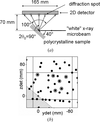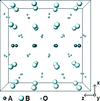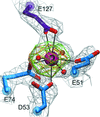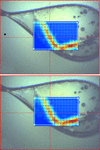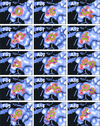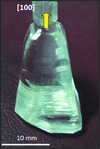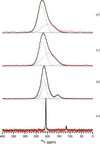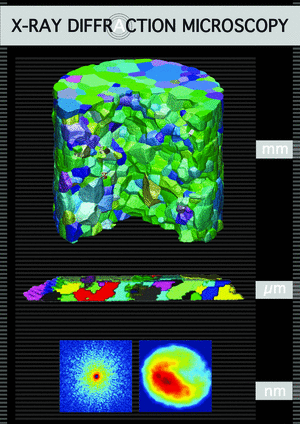issue contents
August 2011 issue

Cover illustration: Selected images of optical birefringence recorded during the heating of dodecasil-3C crystals. Courtesy of Lethbridge et al. [J. Appl. Cryst. (2010), 43, 168-175].
research papers
The surface curvatures and diffraction profiles of a set of sagittally bent Laue crystals with different aspect ratios have been studied to optimize the design of monochromator crystals.
Profiling and parallelization of the full-matrix least-squares refinement program, FMLSQ, using the OpenMP instruction set is described in detail.
Three-dimensional neutron diffraction rocking curves have been used to determine the crystalline perfection of a large aluminium crystal. Several crystalline domains were found in the crystal, and their breadths and relative intensities and the angular distances between them have been determined.
A technique to measure the local full strain tensor using a white X-ray microbeam, a two-dimensional detector and an energy-dispersive detector is presented. It is compared with the monochromatic beam technique normally used to complement deviatoric strain measurements by Laue microdiffraction.
The pore structure of selected metakaolin geopolymers was examined with electron microscopy and by ultra-small-angle and small-angle neutron scattering.
A new algorithm is proposed for extracting the relevant structural information from powder diffraction data. The method does not attempt to extract the integrated intensities, but rather it uses a smaller number of `pseudo-intensities' that contain the same information.
A general method, called GudrunX, has been developed for converting raw X-ray scattering data from a standard laboratory source to the differential cross section and pair distribution function. The method can equally be applied to synchrotron X-ray data.
As an example of the potential of elliptical geometry in instrumentation, a new small-angle neutron scattering (SANS) instrument concept is proposed, in which the neutron source is directly coupled to a half-ellipse. An analytical evaluation of the instrumental performance shows that such an instrument may provide a viable alternative to conventional pinhole SANS for high-resolution measurements and small samples.
Download citation


Download citation


The challenging problem of the determination of both the concentration and location of four different cations on only two inequivalent crystal sites is solved here for AB2O6 columbite samples. This crystal structure investigation is successfully performed by combining neutron and X-ray powder diffraction with spectroscopic measurements such as 57Fe Mössbauer spectroscopy and electron microprobe analysis.
It is shown that the maximum available path length for stress measurements in steels can be remarkably increased by using a neutron wavelength, corresponding to the local minimum of the total cross section near the Bragg edges, configured by a focusing bent perfect crystal Si monochromator.
Complexation with yttrium cations can help to control conditions for protein crystal growth. Bound yttrium cations serve to provide new contacts for crystal formation and also enhance crystal stability.
Download citation


Download citation


The contamination of microfocused Mo Kα radiation by low-energy X-rays is described and quantitatively analysed. A procedure to suppress the contamination is suggested, which guarantees high accuracy in Bragg and diffuse data collections.
On-the-fly adaptive edge scanning and shuttle on-the-fly rastering fluorescence techniques have been developed to improve the efficiency of macromolecular crystallography beamlines.
A microstructure model based on differently clustered stacking faults in face-centred cubic austenite and a DIFFaX implementation of this model are presented. The model is capable of describing the coexistence of faulted austenite, twinned austenite and ∊-martensite in deformed, highly alloyed, austenitic transformation-induced plasticity steels.
Mitigation of errors in pair distribution function analysis of nanoparticles via treatment of the contribution of small-angle scattering, isotropic thermal motion and noise due to counting statistics is explored using simulation studies.
Crystallographic studies combined with biological assays have revealed the relationship between the quality of hit-compound Fo–Fc maps, their binding affinity in protein crystals and their biological activity.
Small-angle X-ray scattering interface distribution functions (IDFs) have been successfully applied to studies of the inter-platelet gallery structure of synthetic montmorillonite modified with a mixture of chemically grafted and physically adsorbed chains of a typical organic modifier. The IDFs are interpreted in the context of two- and three-phase models of the inter-platelet gallery structure, which reveals the regions containing the polar heads and ordered alkyl tails of the organic modifier.
Multiple solutions produced by powder pattern indexing routines are analysed in terms of a reciprocal metric tensor common to the solutions. Given one indexing solution, the approach allows for the generation of further valid indexing solutions.
Hexacarbonyltungsten, W(CO)6, has been decomposed by heating in an autoclave or in a diamond anvil cell at a range of pressures. The decomposition products have been analyzed using synchrotron X-ray diffraction, pair distribution function analysis, Raman spectroscopy and scanning electron microscopy.
Recently developed techniques for performing high-resolution single-crystal neutron diffraction measurements at pressures up to 10 GPa are described.
The use of liquid crystals as dopant in the growth of benzophenone single crystals has significantly enhanced the crystalline perfection; the structural grain boundaries present in the pure crystal have been eliminated, as revealed by high-resolution X-ray diffractometry. The enhanced crystalline perfection has led to improvements in optical transparency and optical polarizability.
Download citation


Download citation


Although C2/m is the space group of the end members of the Sc2Si2O7–Y2Si2O7 system, the intermediate members crystallize in the lower-symmetry C2 space group. The viability of C2, the only alternative space group matching the NMR results requirements, has been demonstrated by means of synchrotron and neutron powder diffraction data.
A combined X-ray diffraction/optical microscopy study has confirmed the accuracy of a previously developed novel energy-dispersive X-ray analysis method for the determination of rutile passivation layer thickness on Magnéli-phase titanium oxide inert anodes.
New insight on the Ge2Sb2Te5 amorphous-to-crystalline phase transition is obtained from combined synchrotron X-ray diffraction, X-ray reflectivity and sheet resistance measurements during thermal annealing. This approach enables direct correlations to be established between structural and electrical changes occurring during the phase transition.
computer programs
The program FOBSCOM analyzes and characterizes the spatial distribution of unmeasured reflections.
A script language to automate Rietveld refinements of powder diffraction data using the GSAS package is presented.
A database of the chemical moieties suitable for the chelative inhibition of biological activity of metal ions in various metalloproteins has been constructed.
Open  access
access
 access
accessA new piece of software for statistical analysis of geometrical, chemical and crystallographic data within the Cambridge Structural Database System is described. This software has been written specifically to deal with chemical structure data and crucially provides simultaneous visualization of the three-dimensional structural information.
crystallographers
Free 

book reviews
Free 



 journal menu
journal menu











